Gaming (DVS Press): Maybe you’ve heard of cultural ground zero: 1997. Now let’s talk games, because unlike other institutions of culture, the games industry kept on growing and innovating for another 10 years. Then 2007 happened, and as far as the bigger publishers are concerned, games reached their peak and no more change or risk was required or even advisable.
Fiction (Wasteland & Sky): SuperversiveSF is putting together a list of some of the best titles of 2020 to share with readers. However, it is also reader selected, which means you can vote for anything, as well. As examples, my books Someone is Aiming for You & Other Adventures and The Pulp Mindset both released last year, so both would be eligible. Multiple folks voting for the same book is encouraged so as to allow them higher visibility on the list for more people to learn about them. In other words, go crazy. We want as many nominations as we can get!
Appendix N (DMR Books): Published in 2017 but, really started several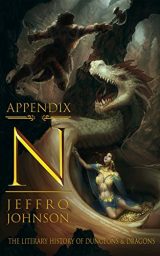 years earlier, was Jeffro Johnson’s book Appendix N: The Literary History of Dungeons & Dragons. The prep work that went into this book earned Johnson a best fan writer Hugo nomination. At the time, Johnson’s Appendix N was the only in-depth exploration of how the works listed in Appendix N of the Dungeon Masters Guide related to the development of D&D. It remains the only such work. Now comes along a book with a suspiciously similar title, Peter Bebergal’s Appendix N: The Eldritch Roots of Dungeons and Dragons.
years earlier, was Jeffro Johnson’s book Appendix N: The Literary History of Dungeons & Dragons. The prep work that went into this book earned Johnson a best fan writer Hugo nomination. At the time, Johnson’s Appendix N was the only in-depth exploration of how the works listed in Appendix N of the Dungeon Masters Guide related to the development of D&D. It remains the only such work. Now comes along a book with a suspiciously similar title, Peter Bebergal’s Appendix N: The Eldritch Roots of Dungeons and Dragons.
Appendix N (The Last Redoubt): You see, this new book, titled, I kid you not, Appendix N: the Eldritch Roots of Dungeons and Dragons, is not, like you would suppose from the title, an exploration of the works in appendix N and how they were woven into the rules, the settings, the assumptions, and the monsters and mythos presented in the game. Instead, it’s an anthology of N stories. In about the same way that all too many hollywood movies are “inspired by true events”, but far less faithful to said events than shining examples like the Chernobyl miniseries. Far, far less faithful.
Review (Porpor Books): As a teenager and sci-fi reader during the 1970s, I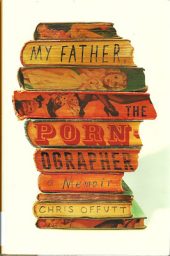 was aware of Andrew J. Offutt (who often used the lower-case spellings of his first name and surname as a ‘gimmick’) as an author and editor of sci-fi and fantasy books. He and his contemporary, Karl Edward Wagner, represented a younger generation of fantasy writers who were inheriting the legacy of people like Lin Carter and L. Sprague de Camp. In large part, this inheritance consisted of writing for Robert E. Howard properties like Conan, Cormac Mac Art, and Bran Mak Morn.
was aware of Andrew J. Offutt (who often used the lower-case spellings of his first name and surname as a ‘gimmick’) as an author and editor of sci-fi and fantasy books. He and his contemporary, Karl Edward Wagner, represented a younger generation of fantasy writers who were inheriting the legacy of people like Lin Carter and L. Sprague de Camp. In large part, this inheritance consisted of writing for Robert E. Howard properties like Conan, Cormac Mac Art, and Bran Mak Morn.
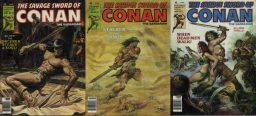 Fiction (Dark Worlds Quarterly): Andrew J. Offutt was no stranger to Robert E. Howard’s work in 1978 when he began his trilogy of Conan novels. From 1975 to 1982, he chronicled the adventures of Cormac Mac Art, another REH creation. In 1977, he edited the first of five volumes in The Swords Against Darkness anthologies, dedicated to fiction in the Sword & Sorcery mode. This included finishing Howard’s “Nekht Semerkeht” and a great dark tale called “Last Quest”. (Earlier in 1976, he published The Black Sorcerer of the Black Castle, a Sword & Sorcery parody.
Fiction (Dark Worlds Quarterly): Andrew J. Offutt was no stranger to Robert E. Howard’s work in 1978 when he began his trilogy of Conan novels. From 1975 to 1982, he chronicled the adventures of Cormac Mac Art, another REH creation. In 1977, he edited the first of five volumes in The Swords Against Darkness anthologies, dedicated to fiction in the Sword & Sorcery mode. This included finishing Howard’s “Nekht Semerkeht” and a great dark tale called “Last Quest”. (Earlier in 1976, he published The Black Sorcerer of the Black Castle, a Sword & Sorcery parody.
Popular Culture (Walker’s Retreat): You are going to have to go out of your way to find the alternatives to the pozzed offerings our seized institutions produce these days. You would think this is obvious, but consider that many people are no different from the Fandom Rejects: they whine and complain about what Big Brand produces, but they won’t take their own side and so much as lift a finger to seek out alternatives. They want to be part of something big, and only Big Brand makes themselves convenient enough to just be there at the touch of a button.
Popular Culture (M Porcius): I never liked Dr. Seuss as a kid. When I was a kid I loved violence and danger and jokes; my favorite thing was Tom and Jerry–I loved it every time Tom suffered some horrendous injury. There was no violence or danger or jokes in Dr. Seuss, at least none I could discern as a child. Dr. Seuss was also so often preachy, telling you to not fight or not chop down a tree or whatever–besides being boring, this seemed ridiculous to me as a kid; sometimes you gotta fight some jerk and sometimes you gotta chop down some tree.
kid I loved violence and danger and jokes; my favorite thing was Tom and Jerry–I loved it every time Tom suffered some horrendous injury. There was no violence or danger or jokes in Dr. Seuss, at least none I could discern as a child. Dr. Seuss was also so often preachy, telling you to not fight or not chop down a tree or whatever–besides being boring, this seemed ridiculous to me as a kid; sometimes you gotta fight some jerk and sometimes you gotta chop down some tree.
Tolkien (Book Riot): Houghton Mifflin Court and HarperCollins announced last Thursday that a special edition of LOTR is being released this October, and it will feature Tolkien illustrated scenes throughout the book. We’ve gotten a taste of Tolkien’s artwork before, as other editions contain the map of Middle Earth he created, as well as his renderings of the Doors of Durin and Balin’s Tomb in The Fellowship of the Ring, and other LOTR-adjacent publications have contained more of Tolkien’s illustrations, but never compiled into the trilogy itself.
last Thursday that a special edition of LOTR is being released this October, and it will feature Tolkien illustrated scenes throughout the book. We’ve gotten a taste of Tolkien’s artwork before, as other editions contain the map of Middle Earth he created, as well as his renderings of the Doors of Durin and Balin’s Tomb in The Fellowship of the Ring, and other LOTR-adjacent publications have contained more of Tolkien’s illustrations, but never compiled into the trilogy itself.
Fantasy (Notion Club Papers): Thus, when the protagonists of a high fantasy are on a journey, then the landscape through which they move is a ‘character’ (or series of characters) in the story. Whereas in a low fantasy (sword and sorcery etc.) the landscape is just an environment: background scenery, or a series of challenges. Providence in high fantasy refers to the fact (or sense) that there is someone in the background influencing the course of events; more generally that there is a purpose or destiny (direction or teleology) influencing events.
New (Steven Pressfield): Then one day, musing about this potential new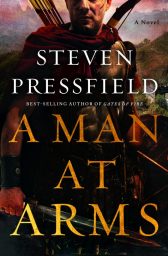 story, it hit me that I could use this Holy Land geography as the setting for an action chase story—Jerusalem, with its Antonia Fortress, garrisoned by the infamous Tenth Legion; Gaza and the coastal plain as the first places to which fugitives might escape; and the Sinai wilderness as a desolate and forbidding “land beyond the law,” across which our heroes (whoever they might be) could flee, pursued by Roman columns and cavalry and every other bad guy I could think of.
story, it hit me that I could use this Holy Land geography as the setting for an action chase story—Jerusalem, with its Antonia Fortress, garrisoned by the infamous Tenth Legion; Gaza and the coastal plain as the first places to which fugitives might escape; and the Sinai wilderness as a desolate and forbidding “land beyond the law,” across which our heroes (whoever they might be) could flee, pursued by Roman columns and cavalry and every other bad guy I could think of.
Board Games (Sacnoth’s Scriptorium): So, perhaps the most successful TSR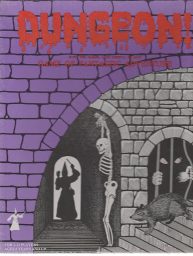 boardgames of them all was DUNGEON, the creation of Dave Megarry,* which went through at least six editions, the earliest as far back as 1975 (the year after D&D itself debuted) and the most recent almost forty years later in 2014. Part of its longevity was no doubt due to its conveying the feel of a dungeon crawl. This must have made DUNGEON a godsend to those who wanted to play D&D but cdn’t find a DM or reliably put together enough people to form a PC party.
boardgames of them all was DUNGEON, the creation of Dave Megarry,* which went through at least six editions, the earliest as far back as 1975 (the year after D&D itself debuted) and the most recent almost forty years later in 2014. Part of its longevity was no doubt due to its conveying the feel of a dungeon crawl. This must have made DUNGEON a godsend to those who wanted to play D&D but cdn’t find a DM or reliably put together enough people to form a PC party.
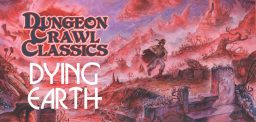 RPG (Goodman Games): At our recent “What’s New With Goodman Games” seminar at Gary Con we debuted the cover art for the complete lineup for the DCC Dying Earth product line—and now we want to share it with you here! This artwork includes covers for the boxed set, the three rules volumes inside the box, and all the adventures currently in the lineup. DCC Dying Earth is both a sourcebook and a setting for the Dungeon Crawl Classics Role-Playing Game that offers a portal to the singular world of The Dying Earth novels by Jack Vance.
RPG (Goodman Games): At our recent “What’s New With Goodman Games” seminar at Gary Con we debuted the cover art for the complete lineup for the DCC Dying Earth product line—and now we want to share it with you here! This artwork includes covers for the boxed set, the three rules volumes inside the box, and all the adventures currently in the lineup. DCC Dying Earth is both a sourcebook and a setting for the Dungeon Crawl Classics Role-Playing Game that offers a portal to the singular world of The Dying Earth novels by Jack Vance.
Cinema (Pulp Rev): Recently, I decided to revisit H.P. Lovecraft’s At the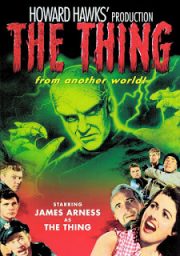 Mountains of Madness and its derivations. I read, for the first time, John W. Campbell’s novella Who Goes There? (clearly inspired by Lovecraft’s story) and revisited the two film adaptations of Campbell’s story, The Thing from Another World (1951) and The Thing (1982). The 1951 and 1982 adaptations are excellent films, both much better than Campbell’s novella.
Mountains of Madness and its derivations. I read, for the first time, John W. Campbell’s novella Who Goes There? (clearly inspired by Lovecraft’s story) and revisited the two film adaptations of Campbell’s story, The Thing from Another World (1951) and The Thing (1982). The 1951 and 1982 adaptations are excellent films, both much better than Campbell’s novella.
Lovecraft (Tentaculii): Lovecraft revered Poe, and entire books could be written on the ramifying connections. Indeed, one such has been. The recent heavyweight The Lovecraftian Poe. Another book could likely be written by tracking down all the times Lovecraft visited a ‘Poe place’, and by gleaning all his sentiments and comments from the letters and poems. That would however be a large task, and must remain beyond the scope of this post.
RPG (R’lyeh Reviews): Robin Hood has been the subject of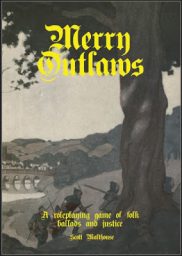 numerous roleplaying games and supplements. Some have been quite comprehensive in their treatment of the outlaw and his band, for example, the supplements Steve Jackson Games’ GURPS Robin Hood and Iron Crown Enterprises’ Robin Hood: The Role Playing Campaign are both highly regarded in this respect, whilst other supplements take a broad approach, such as Sherwood: The Legend of Robin Hood for use with Savage Worlds, or simply touch upon the subject of Robin Hood, such as Romance of the Perilous Land from Osprey Games.
numerous roleplaying games and supplements. Some have been quite comprehensive in their treatment of the outlaw and his band, for example, the supplements Steve Jackson Games’ GURPS Robin Hood and Iron Crown Enterprises’ Robin Hood: The Role Playing Campaign are both highly regarded in this respect, whilst other supplements take a broad approach, such as Sherwood: The Legend of Robin Hood for use with Savage Worlds, or simply touch upon the subject of Robin Hood, such as Romance of the Perilous Land from Osprey Games.
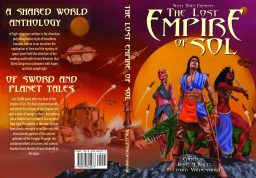 New (Rogue Blades): There’s finally a new book on the block, and this time, it is from Rogue Blades Foundation. This book is about heroes and by heroes! SCOTT ODEN’S THE LOST EMPIRE OF SOL: A Shared World Anthology of Sword & Planet Tales will soon be in your hands! 11 Authors deliver 10 stories about an intergalactic empire’s survival of one major devastation only to face . . . another even worse danger? M.D. Jackson wraps it all up in one suh-weet and glorious cover and adds a grand solar map inside! To top it all off, erudite pulp scholar Fletcher Vredenburgh sets the stage and S&P guru John O’Neill (yes, of Black Gate!) tells us all why S&P is what we need right now.
New (Rogue Blades): There’s finally a new book on the block, and this time, it is from Rogue Blades Foundation. This book is about heroes and by heroes! SCOTT ODEN’S THE LOST EMPIRE OF SOL: A Shared World Anthology of Sword & Planet Tales will soon be in your hands! 11 Authors deliver 10 stories about an intergalactic empire’s survival of one major devastation only to face . . . another even worse danger? M.D. Jackson wraps it all up in one suh-weet and glorious cover and adds a grand solar map inside! To top it all off, erudite pulp scholar Fletcher Vredenburgh sets the stage and S&P guru John O’Neill (yes, of Black Gate!) tells us all why S&P is what we need right now.
Science Fiction (George Kelley): Keith Laumer’s Retief’s War (the third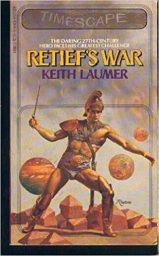 book and the first novel in the Retief series) was serialized in Worlds of If Science Fiction in 1965 with a cool wrap-around cover by Jack Gaughan. Retief’s War has been published in paperback numerous times (I picked the TIMESCAPE cover done by Rowena and the Wayne Barlowe cover on the BAEN Books editions because there’s such a contrast between them).
book and the first novel in the Retief series) was serialized in Worlds of If Science Fiction in 1965 with a cool wrap-around cover by Jack Gaughan. Retief’s War has been published in paperback numerous times (I picked the TIMESCAPE cover done by Rowena and the Wayne Barlowe cover on the BAEN Books editions because there’s such a contrast between them).
Science (Contrapositive Diary): As an SF writer, it’s a topic I have a keen 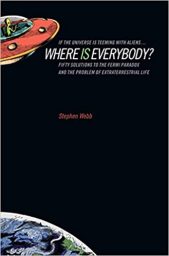 interest in: aliens, and the cogent question asked by physicist Enrico Fermi way back in 1944: If there is life elsewhere in the universe, why haven’t we encountered evidence of it yet? Good question. A lot of really smart people have grappled with it, but the (obvious) spoiler is that we don’t know. (Yet.) Where Is Everybody? is a systematic presentation of fifty proposed explanations for why we’ve not encountered the Galactic Confederation.
interest in: aliens, and the cogent question asked by physicist Enrico Fermi way back in 1944: If there is life elsewhere in the universe, why haven’t we encountered evidence of it yet? Good question. A lot of really smart people have grappled with it, but the (obvious) spoiler is that we don’t know. (Yet.) Where Is Everybody? is a systematic presentation of fifty proposed explanations for why we’ve not encountered the Galactic Confederation.
Science Fiction (Goodman Games): Not many authors can be credited with changing the entire trajectory of a genre, yet Stanley Grauman Weinbaum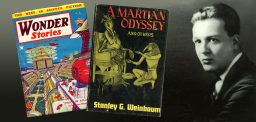 managed to do so with his very first published science fiction story A Martian Odyssey. The story first appeared in the July 1934 issue of the science fiction pulp magazine Wonder Stories, which was a distant third in popularity to Astounding Stories and Amazing Stories.
managed to do so with his very first published science fiction story A Martian Odyssey. The story first appeared in the July 1934 issue of the science fiction pulp magazine Wonder Stories, which was a distant third in popularity to Astounding Stories and Amazing Stories.
Cinema (Modern Horrors): As SXSW kicked off this year, I knew almost nothing about Mickey Keating’s new film, aside from the single sentence logline and several members of the cast. That small amount of information was enough to have me hooked, and I’m certain that I made the right choice. I can confidently say that Offseason was my favorite fiction film of this year’s festival. The setup is simple: Marie Aldrich (played note perfectly by Jocelin Donahue) receives a letter stating that her mother’s grave has been desecrated, and as the only living relative, Marie must come to the tiny island village to survey the damage and determine what is to be done.
Memoirs (Rough Edges): I consider myself fortunate to have traded a few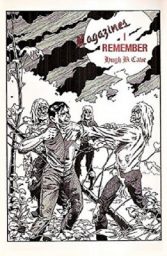 emails with Hugh B. Cave before he passed away. Like nearly all of the old pros I’ve met or corresponded with, he was a true gentleman and always a pleasure to hear from. A legendary pulp writer who had a long, prolific career in their pages, Cave was unusual in that he moved on to other things and continued writing successfully all the way into this century.
emails with Hugh B. Cave before he passed away. Like nearly all of the old pros I’ve met or corresponded with, he was a true gentleman and always a pleasure to hear from. A legendary pulp writer who had a long, prolific career in their pages, Cave was unusual in that he moved on to other things and continued writing successfully all the way into this century.
Fiction (DMR Books): Fickle memory is telling me that I discovered Manly Wade Wellman through my local library. Back in the very early ‘80s his run of Doubleday novels filled the shelves there, as did Stuart Schiff’s Whispers and Charles L. Grant’s Shadows anthologies. It was a glorious time in genre fiction. There’s something unique about Manly’s fiction that appealed to me, and it was perhaps the innate dignity and inherent decency of his protagonists, a common thread that runs through all of them. In a time of moral ambiguity and the antihero-types, I found this very appealing.
Fiction (Easily Distracted): Machen must have read The Strange Case of Dr. Jekyll and Mr. Hyde to tatters. Its confidence, buoyancy, and protean economy produce effects that foreshadow Machen’s own. At the beginning of Stevenson’s tale, Enfield is reporting a crowd’s reaction (and his own) to the sight and proximity of Mr. Hyde after Hyde has assaulted a girl.
Sherlock Holmes (Crimereads): Which brings us to the mystery of Sherlock Holmes. If you’ve read a Holmes story, chances are you’ve read another, and if you’ve read two, you’ve probably read them all and re-read them all, and chances are you’ve picked every bone of that corpus clean, with a great deal of relish. Why on earth would you do that? Where’s the mystery in that? I’ll spill my solution up front: the mystery is in Holmes. It’s been said that next to Jesus and Hamlet, Sherlock Holmes has had more ink spilled about him than any man, real or fictional.
Fiction (Paperback Warrior): Canadian-American author David Morrell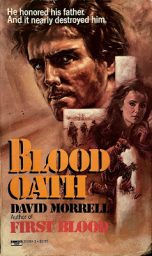 wrote First Blood in 1972 as his first published novel. The book was adapted into the blockbuster film launching the successful Rambo film franchise. With nearly 30 novels to his credit, Morrell has practiced in multiple genres including horror, action-adventure, mystery and even comics. I’ve always enjoyed his work and have owned his 1982 novel Blood Oath for awhile. The back cover features a Stephen King blurb that says he defies readers not to finish this novel in a single sitting. Taking the horror icon’s challenge, I opened to the first page.
wrote First Blood in 1972 as his first published novel. The book was adapted into the blockbuster film launching the successful Rambo film franchise. With nearly 30 novels to his credit, Morrell has practiced in multiple genres including horror, action-adventure, mystery and even comics. I’ve always enjoyed his work and have owned his 1982 novel Blood Oath for awhile. The back cover features a Stephen King blurb that says he defies readers not to finish this novel in a single sitting. Taking the horror icon’s challenge, I opened to the first page.
Biography (The Federalist): That is why the character endures; Howard transported readers to an age where all one needed was quick wits and a flashing blade. Howard was indeed a genius, but one doesn’t really get a sense of that in Vick’s biography, which, sadly, comes across as a hasty first draft.
Thanks for the mention. I’m biased, admio, but The Lost Empire of Sol is a whole lot of sword & planet action.
admittedly
-
For a second there, I thought you were trying to slip in some Italian (or Corsican or Sardinian, maybe Maltese) slang, Fletcher!
Another fine Sweep!
That Superversive booklist sounds like a good idea.
Quite the one-two punch on Bebergal’s “Appendix N”.
I got some good chuckles out of that Dr. Seuss link.
The upcoming LotR edition sounds awesome!
An excellent post from Cheah on THE THING.
Robert Louis Stevenson was a true pioneer. The Baptist to Haggard’s Exotic Adventure Messiah. Plus, RLS wrote some horror, which HRH did not.
What a set of links!
That upcoming release of LotR sounds great, I just lack the shelf space at the moment.
Great post from Cheah on the Thing, and not just because I agree with him.
Kudos to DMR blog for offering a look at both sides of the discussion of Bebergal’s book.
Always nice to see Robert Louis Stevenson get some attention; he was a favorite of my parents when I was growing up (The Black Arrow and Master of Ballantrae esp).
As a side note: Deuce is right when he says that Haggard never wrote horror, but he could have. Take a look at his novel Cleopatra for example. It is a blood- spattered Victorian tragedy with a high body count and atmosphere you could cut with a khopesh. The opening sequence is just one step from fitting into any mummy movie made in the last 90 years and the “hero” is the one who gets entombed alive.